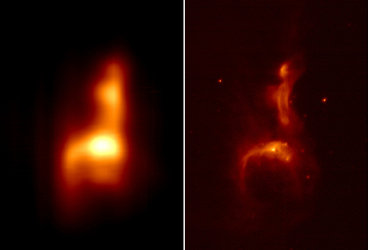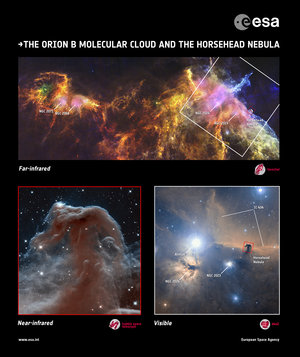

Flame Nebula in visible and infrared light
The Flame Nebula, located about 1,400 light-years away from Earth, is a hotbed of star formation less than 1 million years old. Within the Flame Nebula, there are objects so small that their cores will never be able to fuse hydrogen like full-fledged stars—brown dwarfs.
This collage of images from the Flame Nebula shows a visible light view from the NASA/ESA Hubble Space Telescope on the left, while the two insets at the right show the near-infrared view taken by the NASA/ESA/CSA James Webb Space Telescope. Much of the dark, dense gas and dust, as well as the surrounding white clouds within the visible light image, have been cleared in the near-infrared images, giving us a view into a more translucent cloud pierced by the infrared-producing objects within that are young stars and brown dwarfs. Astronomers used Webb to take a census of the lowest-mass objects within this star-forming region.
In this image, light at wavelengths of 1.15 microns and 1.4 microns (filters F115W and F140M) is represented in blue, 1.82 microns (F182M) as green, 3.6 microns (F360M) as orange, and 4.3 microns (F430M) as red.
[Image description: A collage of three images showing a dusty nebula. The left two-thirds of the collage is taken up by an image of the nebula in visible light. The remaining third is taken up by two other images, one atop the other, in near-infrared. Wispy plumes appear to fly off from the pillar toward the sides amid blue clouds of the same material, which are whiter near the pillar. There are many white stars spread throughout. Two separate, white squares, tilted about 30 degrees, outline two areas in the pillar. Both images contain a mixture of reds, blues and browns, and show red, blue, and white stars.]





